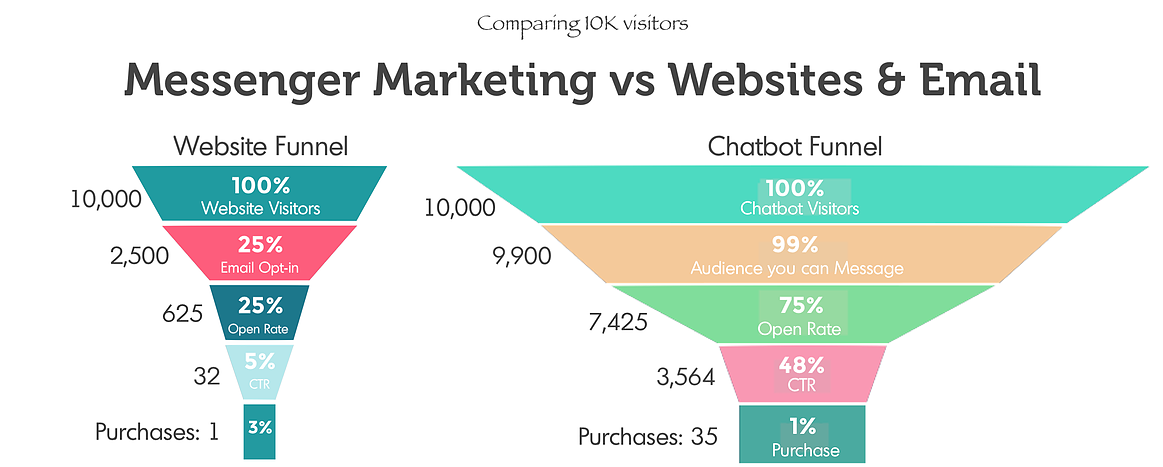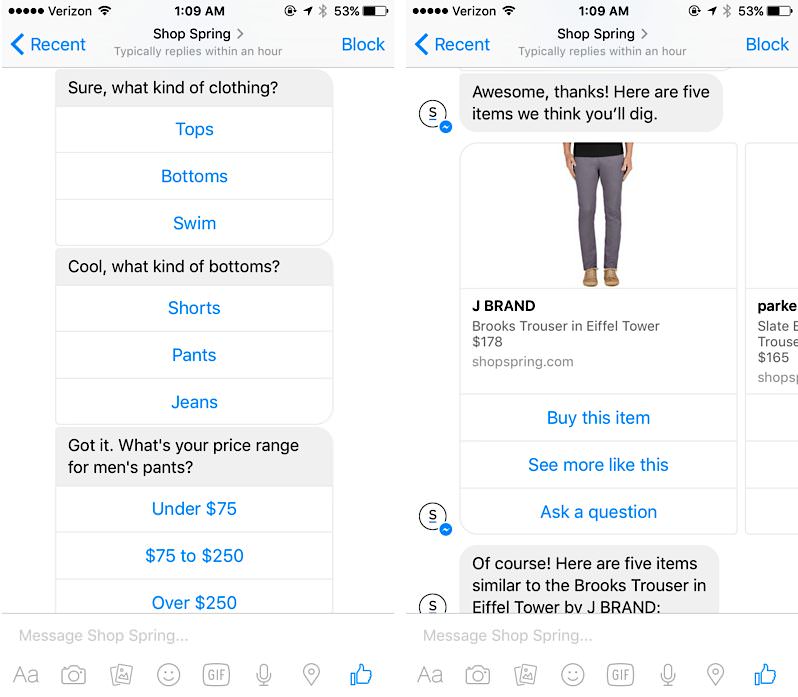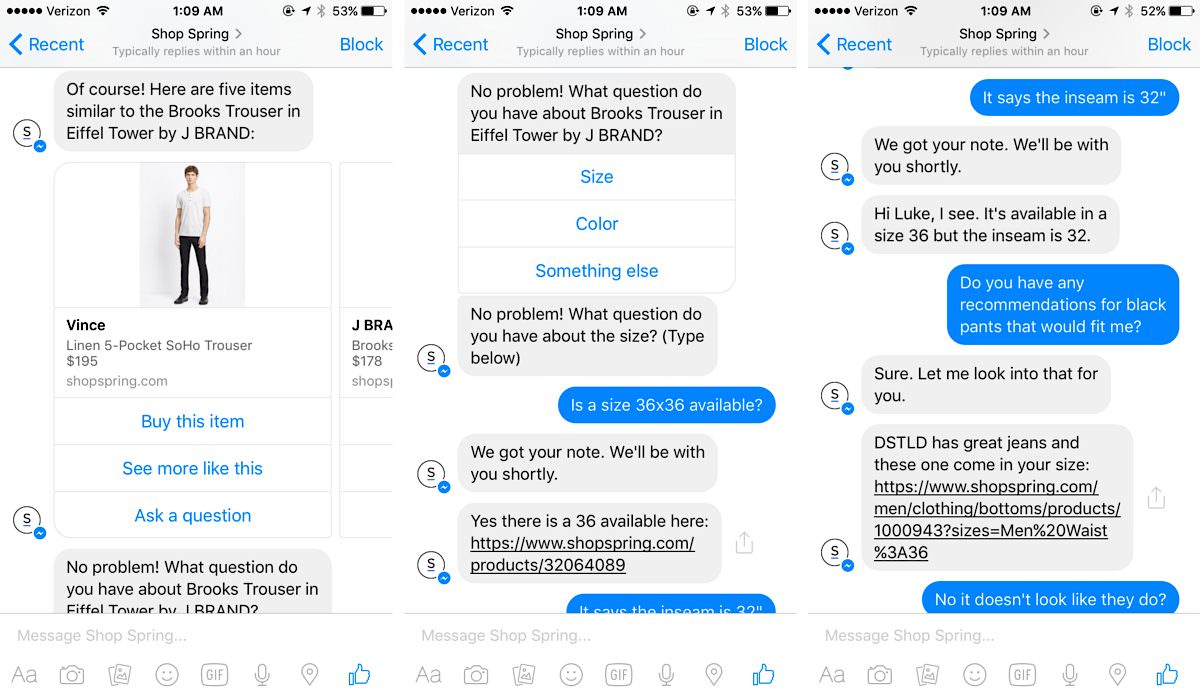Answers
Jan 08, 2019 - 04:48 AM
I have a rather radical opinion of messenger bots – that they are a mashup of mobile, social, instant messaging power. Digital marketing is headed to this exact direction. The last thing you would want is to become antiquated as to why things are not working as well as they used to when you started.

It is undeniable that people are moving away from emails, phone calls, and SMS. We have rapidly moved to mobile-friendly messenger apps like Facebook Messenger, iMessage, SnapChat, and Whatsapp to keep in touch with family, friends, and even businesses.
One thing that is true in business is that companies gravitate towards the communication channels that consumers are already using. Makes sense, right? It is from this foregoing that we derive the term messenger marketing. Messenger marketing is the act of leveraging mobile chat platforms to facilitate conversions and e-commerce with your customers and prospects.
Before we get started, let me catch your attention by asking whether you have ever had a chat with a Skype or Messenger “customer service rep”. If you have, then chances are that you got help from a bot (short for robot).
Why then do these bots seem to have a seemingly legitimate value proposition compared to traditional landing pages? For some businesses, it is not very clear. One certain thing though, is that Messenger has a higher average conversion rate compared to the average landing page, whose conversion rate is often not more than 10%. This implies that you lose up to 90% of potential customers from traffic you have already paid for.
This is where Messenger and other similar bots have an edge and potential for increasing conversion rate and enhancing customer experience. Where are the facts, you may ask. I am totally persuaded that bots have a solid chance to make your business more successful. My basis for this persuasion is that it is hard to argue with facts and data- bots have 88% open rates and 56% click-though rates.

Another hard truth is that many of your prospective customers are no longer comfortable trading their email addresses for your free download. Worse still, email fatigue is real and they are more likely to ignore your marketing emails completely. Customers find it harder to opt into an email newsletter as opposed to opening up a Messenger thread.
From the perspective of an e-commerce storeowner or marketer, you can agree with me that building an email list takes a lot of work and time than creating a list of Facebook Messenger leads. Messenger offers a one-click subscription instead of leads having to type in their email addresses, confirming them and submitting them.
Besides generating less friction, this phenomenon also reduces the perception of trading their emails with newsletters. Since most subscribers might not know that they are interacting with a bot, there is more trust as there is a human feel to chatting with support.
Since messenger bots also have sequences like emails, they tend to be faster than email sequences. Typically, you have to wait for a day or two before sending additional emails to your subscribers. Owing to chat bots’ faster (almost instant) response rate, you can send subsequent messages more frequently and you can engage in real conversations with your leads. This ensures faster closure and lesser friction in sales.
Retargeting our messenger leads becomes easier than email leads since most if not all your leads are already on Facebook – Messenger receives approximately 1.2 billion active users every month! Imagine trying to get in-depth information about your customer such as where they went to school, where they work, their age, and gender through email! With Messenger, for instance, you already have this information.
How to create a bot and Good Bot Examples
All these are advantages of using messenger chat bots over mainstream email marketing. How easy then is it to set up your own interactive bot and campaign?

If you are an avid Redditor, you probably have seen the comment, “Bad Bot”a couple of times. Still, there are good bots, like the “RemindMe! Bot”on Reddit. A couple of resources –some free- are available online to help you build a bot for your ecommerce store. Remember that you do not always have to reinvent the wheel and might just use preexisting bots with a little customization.
Creating messenger bots is not a complicated task, if you may ask. There are a couple ways to go about this:
- Hardcore coding
- The easy way
If you are armed with programming experience and know your way around coding languages and frameworks such as Python, Heroku, and Flask, then you should consider making your own bot instead of buying a course.
If you are like me and have limited code knowledge, then you can choose the easy way.
Hardcore Coding
I will not go into the step-by-step flow on how to create a bot but if coding is your jam, here are a few resources to get you started:
(YouTube Series): Make your Own Facebook Bot
Nowadays, if it is not on YouTube, it probably doesn’t exist. This nice video tutorial will give you a nice visual lesson on creating a bot using the Facebook Messenger Platform API.
(GitHub) Creating your own Facebook Messenger Bot
GitHub is a harbor of coding resources and shared APIs and this guide is nothing short of it. It is a quick comprehensive guide for beginners and intermediaries.
Facebook Messenger Bot Tutorial: Step-by-Step Instructions for Building a Basic Facebook Chat Bot
This article by Hartley Brody has a ton of helpful resources on Messenger bots, which provides a helpful starting point in your journey in conquering this new marketing phenomenon.
Facebook Developers – Messenger Platform
One thing I like about Facebook is that it is always open to helping its developers build programs based on its API. This tutorial by Facebook is suited for advanced coders and teaches the basics of building a functioning bot in 15 minutes.
The Tom, Dick, and Harry way
Should coding not be your cup of tea, here is a simple hack to leveling your playing field with coding professionals:
A site that I will recommend to help you get your bot running in minutes is MobileMonkey. They have a straightforward approach to creating your bot in an intuitive fashion. Remember to check the permissions that you have to grant them concerning accessing information on your Facebook.

Besides MobileMonkey, there are other tools to help you create your bots:
Bot Academy is an educational resource that has plenty of helpful articles, data and tutorials to build Facebook Messenger bots.
Chatfuel is a leading innovator in the chatbot industry and promises to help you launch a full-featured chat bot in 7 minutes! One thing I liked about this platform is that its value proposition is quantifiable- free up to 500,000 monthly active users- which is good if you are just looking to get your feet wet without the ties of a monthly subscription.
Sequel is one good tool that not only teaches you how to make a Facebook Messenger Bot but also leverage other platforms such as Telegram, Kik and Viber. This tool uses pre-existing templates to help you get started.
Botsify is an AI-based bot platform that is used by big brands like Shazam and Apple. It has a thrilling integrations experience based on plugins. Since most of us marketers are not programmers, you will be thrilled with the drag-n-drop template designer.
ChattyPeople is a basic AI-centric customer support bot that is helpful in building fluid customer support chat system.
Other platforms that are worth mentioning are ManyChat, Meokay, Bot List, and Assist.
Lastly, Chris Makara has an authoritative guide on building a working chatbot, which he updates fairly frequently. I recommend reviewing it and joining his list for additional tips.
Conclusion
The point here is simple. It means that marketers are able to build modern chat bots that are advanced, more compelling, and more functional. This will make your store more effective in 2019 and beyond. What you have right now is a chance to use one of the newest tools in digital marketing.
While Messenger marketing is still relatively new and unknown to most people, you can join the bandwagon of early adopters. My prediction is that in the coming year, maybe one, or two, this will be a very different scene.

Feb 13, 2025 - 10:15 PM
Yes, many businesses have successfully used Messenger bots to drive sales by automating customer interactions, providing instant responses, check and guiding users through the buying process. Brands use bots for product recommendations, lead generation, abandoned cart recovery, and personalized promotions, significantly increasing conversions. With platforms like ManyChat, Chatfuel, and Meta’s Messenger API, businesses have reported higher engagement rates and sales growth through conversational marketing.






Add New Comment